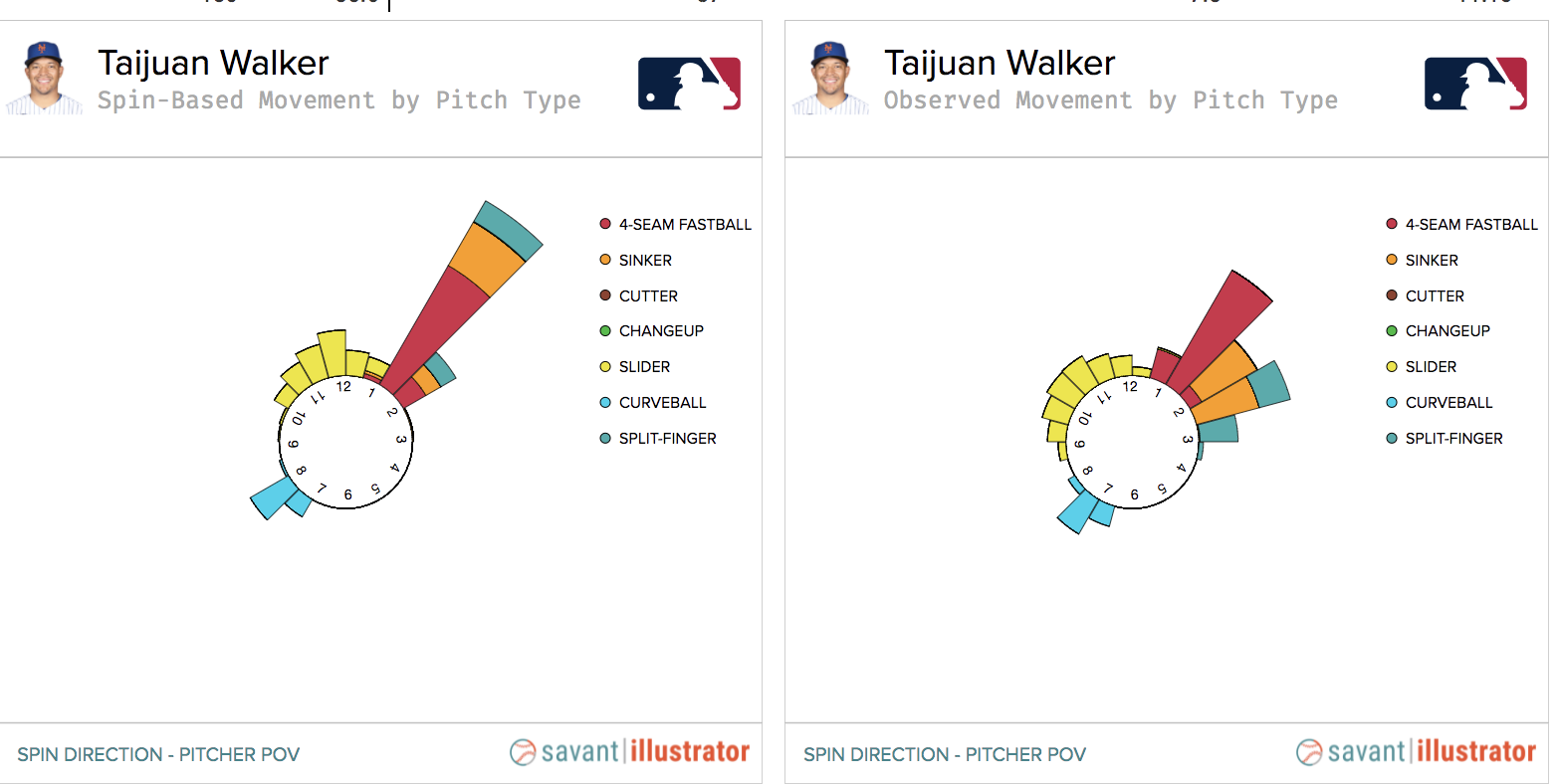The Mets have been one of the biggest surprises so far this season. They did come into the year with high expectations, but they have faced worse injury luck than just about any team in Major League Baseball. Despite having to run out lineups filled mostly by AAA players for parts of the season, the Mets are in first place in the NL East. With Noah Syndergaard and Carlos Carrasco having not pitched all season, the Mets have needed to turn to their depth behind Jacob deGrom and Marcus Stroman. Taijuan Walker has been all they could’ve asked for and then some.
Walker’s career has been a bit of a roller coaster ride to this point. He was once considered one of the top pitching prospects in all of baseball prior to his call up to Seattle at age 20. He struggled a bit out of the gate, which is not uncommon for a pitcher in the big leagues at such a young age. Despite a couple of subpar seasons, Walker was acquired by Arizona as a major piece of the trade involving Ketel Marte, Mitch Haniger, and Jean Segura. Walker could not reach expectations in Arizona, primarily because of injuries. He pitched just 14 innings in 2018 and 2019 combined, leading to a non-tender the following offseason.
Seattle then picked him back up on a one-year deal. Walker turned his career back around in the 2020 pandemic-shortened season, pitching to a 2.70 ERA split between Seattle and Toronto, who acquired him at the trade deadline. Although this was a small sample, the Mets saw enough to sign him to a 2-year, $20 million deal this past offseason. And boy has that paid off.
The Basics
Taijuan Walker has always been a guy who has overperformed his peripheral metrics.
Stats like FIP and SIERA have lots of flaws but are generally better at describing past performance and predicting future performance than ERA. Walker falls under the umbrella of players these metrics tend to underrate. This attribute is primarily shared by pitchers who thrive off generating weak contact without a particularly high strikeout rate, such as Kyle Hendricks, Hyun Jin Ryu, and fellow Mets teammate Marcus Stroman. With pitchers like this, it’s important to dig deeper and try to encapsulate how close to their sample ERA their true talent level lies.
Quantity over Quality
Walker does not have particularly elite stuff. He has never been a guy that can blow you away with a couple of great pitches — none of his pitches carry a high whiff rate — and that’s fine. It seems like post-injury, he realized needed to rely on more pitches to be successful. In 2015, Walker threw his 4-seam fastball 62.9% of the time. In 2021, while it is still his most commonly thrown pitch, the usage has dropped to 32.9%. He has since added a slider and heavily increased the usage on his 2-seam fastball.
With 5 pitches that he can turn to consistently, it is difficult for batters to develop a game plan against him. He does tend to use the slider and 2-seamer against right-handed batters and the splitter and curveball most commonly against lefties, but other than that, he has no real trend in his pitch usage. He is comfortable turning to any of his pitches in any count.
 At the release point, Walker’s 4-seam fastball, sinker (2-seamer), and splitter all have virtually the same spin direction. However, they are in different places looking at the observed movement diagram. Essentially, all 3 pitches appear the same coming out of Walker’s hand, making it difficult to decipher before it’s too late. This can be even more difficult on righties who can’t see the grip as well. The curveball almost perfectly mirrors the fastballs, which provides a similar effect. None of these pitches may be elite, but they play perfectly off each other. He essentially has four pitches that appear the same at release point, but all move differently.
At the release point, Walker’s 4-seam fastball, sinker (2-seamer), and splitter all have virtually the same spin direction. However, they are in different places looking at the observed movement diagram. Essentially, all 3 pitches appear the same coming out of Walker’s hand, making it difficult to decipher before it’s too late. This can be even more difficult on righties who can’t see the grip as well. The curveball almost perfectly mirrors the fastballs, which provides a similar effect. None of these pitches may be elite, but they play perfectly off each other. He essentially has four pitches that appear the same at release point, but all move differently.
This spin direction profile reminds me of Lance Lynn. Lynn’s repertoire pretty much only consists of three different types of fastballs: a 4-seamer, a cutter, and a sinker. He is able to succeed because of how similar the pitches appear at the release point, as shown in this excellent overlay from Pitching Ninja.
Lance Lynn's 3 "Fastball" Variations (with tails). 😯
92mph Cutter
95mph Four Seam
93mph Sinker pic.twitter.com/QbR8UBGYwg— Rob Friedman (@PitchingNinja) May 25, 2021
Although Walker does generate nearly the same level of fastball spin as Lynn, both pitchers thrive off how their pitches play off each other, despite below-average velocity.
Walker has proved that as a starting pitcher, it is sometimes better to have several good pitches than one or two great pitches. He has a run value below zero (better than average) on all five of his pitches. Only three other pitchers — Zack Wheeler, Chris Bassitt, and Kyle Gibson — have done the same this season.
Command
For a pitcher that does not thrive on getting batters to chase pitches with elite movement, Walker needs to rely on command.
He does have below-average CSW on splitter and slider, but this is likely because he doesn’t generate as many whiffs on these pitches as most other pitchers. He does make up for this with a ground ball rate above 50% on his splitter. Walker’s fastball command is so strong that his total CSW% ranks among the best in the league. Since CSW is just “called strikes plus whiffs” and does not deal with any lurking variables, it can be very reliable, even in a small sample.
Walker has emphasized the first pitch of the at-bat as the most crucial for him. His true first-pitch strike % currently sits at 56.6%, which is well above average. He is confident turning to any of his five pitches on empty counts to help him gain an advantage on the batter with a first-pitch strike. Additionally, all five of his pitches carry strong called strike numbers, which is crucial considering his low whiff rate.
Slight Causes for Concern
When we’re talking about a pitcher with a 2.17 ERA, it is very likely there are going to be some flags that signify regression. First off, Walker’s flyball rate has gone up from last year. Playing his home games in Citi Field, a ballpark that generally suppresses home runs, certainly helps. However, it is hard to imagine his 3.4% HR/FB rate, which is the lowest among qualified pitchers, will be sustainable over the course of a full season. His xwOBA against is significantly greater than his wOBA, although, similar to the aforementioned FIP and SIERA, Walker has always overperformed his expected metrics. I do expect these numbers to normalize as the season goes on, but I wouldn’t be too worried about Walker. If Walker pitches to a 3.50 ERA the rest of the season, I couldn’t imagine any Mets fan or fantasy manager being disappointed.
The biggest concern about Walker’s profile has been his increase in walks. For a pitcher who thrives on command, it is important for him to keep walks down. Bad batted ball luck can lead to a lot of runs against if Walker gives out too many free passes.
Moving Forward
It’s inevitable that Walker will eventually regress from this unsustainably low ERA. However, nobody expected him to be a sub-2.5 ERA. Walker is an example of how pitches that play well off each other can be more important than the quality of the pitches themselves. He is a perfect representation of how you can succeed without elite velocity or spin rate. He has rebounded well coming off his injury and has offered a massive return on investment for the Mets.
Photo by Rich von Biberstein/Icon Sportswire | Feature Image by Justin Redler (@reldernitsuj on Twitter)


Hmmm, is this the same Tijuan Walker Nick was poo-pooing the first two months of the season?